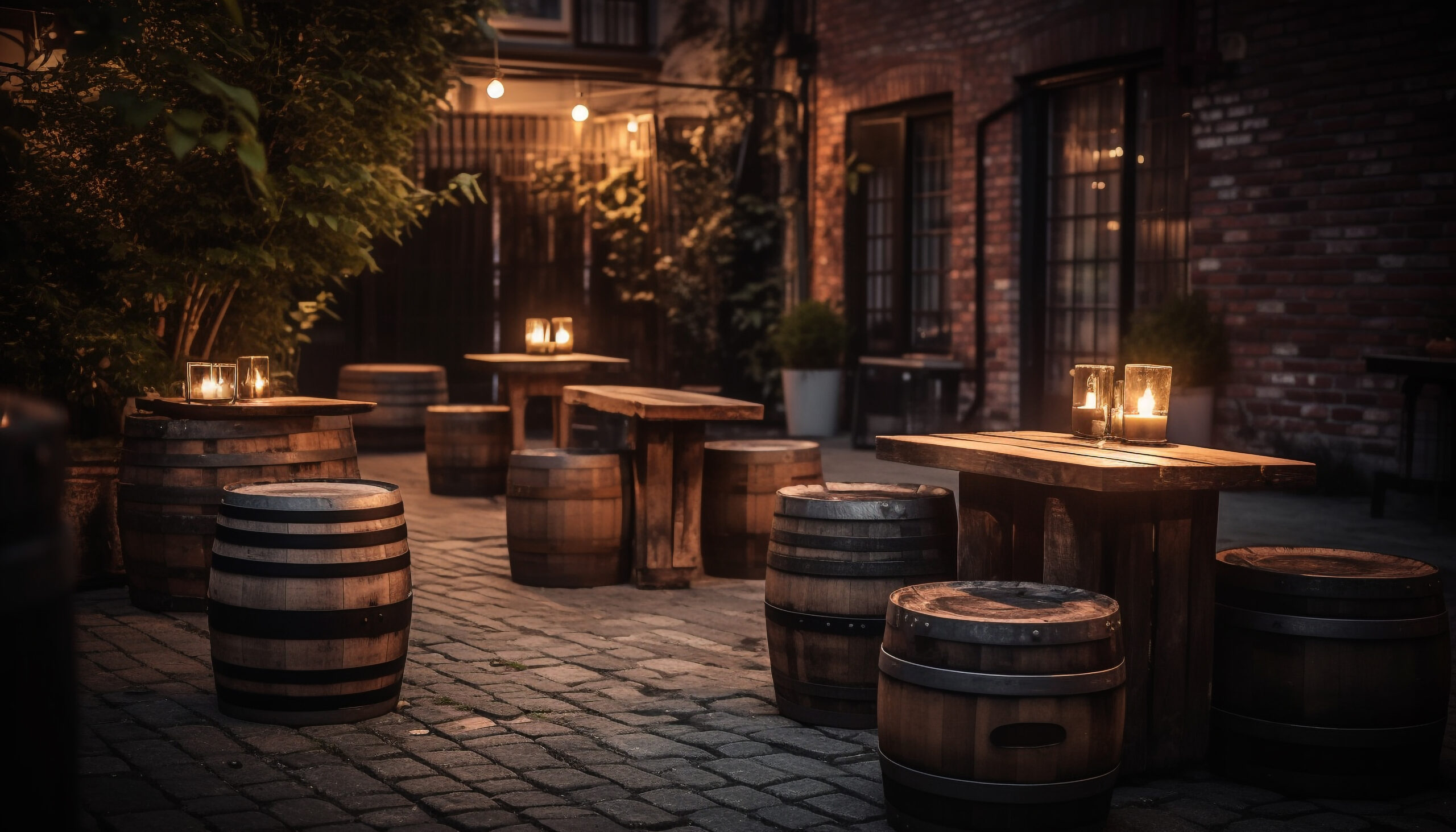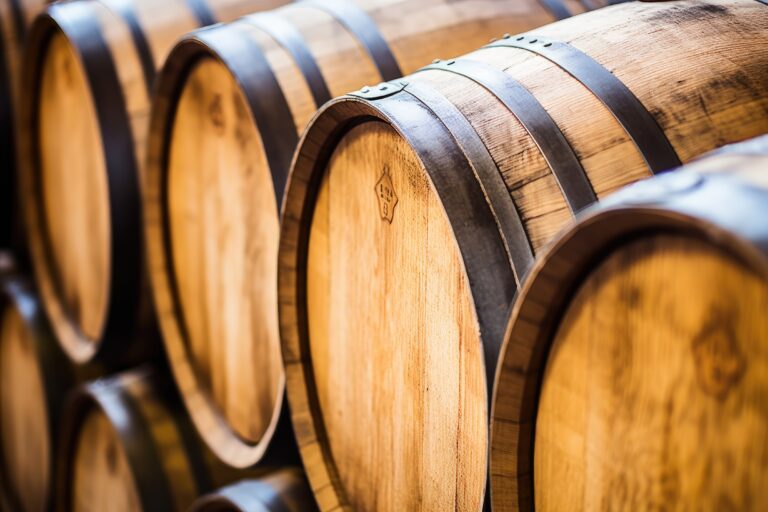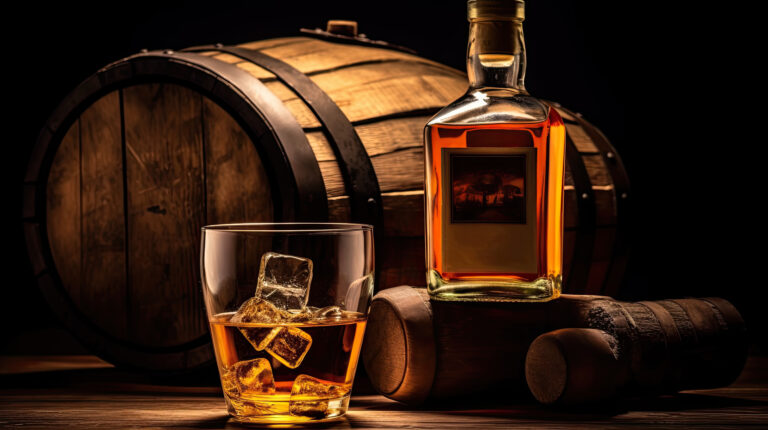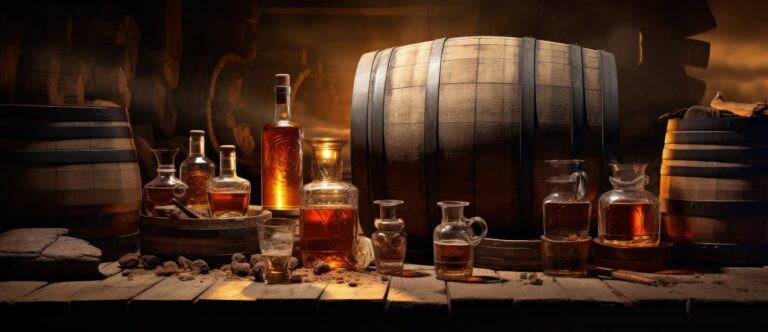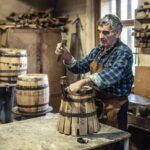Have you ever stopped to think about what happens to those oak barrels after they’ve cradled whiskey for years? You might be surprised to learn they get a pretty fascinating second act! Once a barrel has lent its rich, oaky flavor to a distiller’s chosen spirit – typically anywhere from 3 to 50 years, depending on the whiskey style – it’s emptied and moved out of the rickhouse. But for these well-traveled casks, their story is far from over.
Selecting the Right Wood for Whiskey Barrels
Choosing the perfect wood is absolutely vital for crafting whiskey barrels. Only specific types of oak possess the ideal qualities to infuse the spirit with flavor. American white oak is the gold standard because its wood is both strong and porous, allowing for a beautiful interaction between the liquid and the barrel.
The oak planks are meticulously cut into staves, which are then curved to form that iconic barrel shape. These staves need to be carefully selected and matched to ensure the barrel is completely watertight. You’ll typically see two common shapes: the bulge and the tapered variety. Bulge barrels offer more surface area, meaning they impart more flavor to the whiskey. Tapered barrels are often chosen for whiskies that require a lighter oak influence.
It’s crucial that the wood is properly seasoned before it’s transformed into a barrel. Freshly cut wood is just too wet and can warp during aging, plus its moisture can negatively impact the final flavor. So, these staves are air-dried for at least six months to reduce moisture and concentrate those vital wood compounds.
The inside of the barrel gets a special treatment: charring. This process caramelizes the wood sugars and creates a layer of charcoal. The level of char depends on the desired effect, ranging from light (for a more subtle oakiness) to heavy (for bold, smoky notes). This char is a flavor powerhouse, releasing compounds like vanillin that give the spirit its distinctive taste.
Interestingly, these barrels are held together with steel hoops instead of nails or pegs. This clever design allows the wood to “breathe” and the barrel to slightly swell and contract with temperature changes. The tiny gaps created by these hoops also facilitate evaporation and the concentration of flavors during aging – part of what makes whiskey so complex!
With the right wood and expert production techniques, whiskey barrels truly become alchemists, transforming distilled spirits into that beautiful amber gold. And the lifecycle continues, as many of these barrels go on to age other spirits or find new life as unique furniture or decor. A truly noble end for such an integral part of crafting fine whiskey.
Building Barrels at the Cooperage
Once those oak logs have been expertly cut and cured, their next stop is the cooperage to be meticulously crafted into barrels. The cooperage is where skilled barrel makers, known as coopers, work their magic, turning oak into the watertight containers essential for aging spirits like whiskey.
The journey begins by splitting the logs lengthwise into the staves that will form the sides of the barrel. These staves are then carefully shaped and beveled to ensure they fit together perfectly, forming a tight seal.
Next, hoops made of metal rings are carefully fitted around the outside of the staves to hold everything securely in place. Then, the barrel heads, those circular pieces of wood with a hole in the center, are fitted onto either end.
The inside of the barrel gets its signature char by being burned. This vital step helps impart both flavor and color to the spirit. The level of char is a precise art, depending on the barrel’s intended use; whiskey barrels typically receive a heavy char for that signature taste.
Once assembled, every barrel undergoes a thorough inspection to guarantee it’s absolutely watertight before it’s filled with whiskey or other spirits. As the spirits age, they gradually absorb the wonderful flavors from the wood and the char.
After a few years of aging and mellowing the whiskey, the barrels are emptied. Many are then sold as “used barrels” to age other spirits like rum, brandy, or wine. Some are creatively recycled into furniture, decorative items, or even planters. And a lucky few are transformed into stunning whiskey barrel chairs, stools, or tabletops.
It’s truly fascinating to witness how a humble oak log is crafted into a barrel, nurtures whiskey during its aging journey, and then finds an entirely new purpose in various forms. The lifecycle of a whiskey barrel is a testament to quality craftsmanship and thoughtful sustainability. Cheers to that!
Charring the Inside of Whiskey Barrels
Once whiskey barrels are assembled, their insides are carefully charred to dramatically enhance both flavor and color before they’re filled. Charring involves intentionally burning the inside of the barrels to create that crucial layer of charcoal.
The barrels are rotated precisely over an open flame, which burns the wood and forms that essential layer of charcoal. This char layer acts like a natural filter, helping to mellow and refine the whiskey as it ages.
Beyond filtration, the char layer is also responsible for giving whiskey its distinctive brown color and some of its delightful smoky flavors. The intensity of the char is a key decision, varying by whiskey type – bourbon typically demands a heavier char, while Scotch often utilizes a lighter touch.
The Charring Process
The charring process, sometimes referred to as “toasting” the barrels, involves methodically rotating the barrel over an open flame to char the interior. Coopers expertly use gas-burning equipment to meticulously control the level of charring. The barrels are constantly rotated to ensure an even and consistent char.
Once the desired char level is achieved, the barrels are cooled and then rigorously tested to ensure there are absolutely no leaks before they’re shipped to distilleries for filling. The char levels are typically categorized as:
- Light Char #1 – This gives a light brown color with hints of vanilla and caramel. Often used for some Scotch whiskies.
- Medium Char #2 – Results in a dark brown hue with notes of caramel and chocolate. This is a common char for most bourbons and whiskies.
- Heavy Char #3 – Nearly black, this char delivers robust smoky flavors. Used for certain bourbons.
- Alligator Char – A very heavy char with a distinctive, visible wood grain, providing an abundance of smoky flavors. Also used for some bourbons.
The charring process is an absolutely crucial step in imparting whiskey with its signature taste and aroma. The char layer created inside the barrels helps to mellow and filter the whiskey during aging, infusing it with wonderful flavors of vanilla, caramel, and smoke. Charring is a centuries-old practice that remains an integral, timeless part of crafting truly great whiskey.
Filling Barrels With Whiskey for Aging
Once those barrels have been meticulously toasted and charred to the distiller’s exact specifications, it’s showtime: time to fill them with distilled spirit for aging and maturation. The distilled spirit, typically crafted from fermented grains like barley, rye, or corn, is carefully pumped into the barrels at a high proof, usually around 125 proof or 62.5% ABV.
As the spirit settles into its new home within the barrels, a fascinating series of chemical reactions begins to unfold, ultimately bestowing aged whiskey with its distinctive caramel color and incredibly complex flavors. First off, the spirit slowly soaks into the charred wood, eagerly extracting compounds like vanillin along with tannins, lignins, and hemicellulose. The gentle heat causes the wood’s polymers to break down into a symphony of aromatic and flavorful compounds.
Oxygen also plays a key role, subtly entering the barrel through the wood, which helps to mellow the spirit. And then there’s the famous “angel’s share” – about 2% of the whiskey evaporates each year. This evaporation is a good thing, as it concentrates the remaining flavor compounds, intensifying the final product.
Environmental factors, such as the natural temperature variations across the seasons, significantly influence the aging process. Colder weather encourages the whiskey to seep deeper into the wood, allowing it to pick up more oak characteristics. Warmer weather, on the other hand, leads to increased oxidation and evaporation. Over time, these consistent temperature changes work their magic, producing a beautifully smooth, mellow spirit.
The aging period itself isn’t a one-size-fits-all duration; it really depends on the type of whiskey. For instance, Bourbon must be aged for a minimum of two years. For Scotch whisky, the minimum is three years. And for truly premium whiskies, they’re often aged anywhere from three to an impressive 30 years or even more, all to achieve an exceptionally complex and nuanced flavor profile. Once it reaches its peak maturity, the whiskey is carefully bottled as a premium aged spirit, ready to be savored neat or mixed into classic cocktails.
The life of a whiskey barrel is truly about transformation, providing aroma, flavor, and color to the distilled spirit within. While their primary “useful life” is focused on aging, these whiskey barrels play an absolutely integral role in crafting a premium aged spirit before embarking on new adventures as decor or furniture. The barrels may be emptied, but their profound presence lives on in every single bottle of fine, aged whiskey.
Monitoring and Rotating Barrels During Aging
Once barrels are filled and carefully sealed, the intricate aging process truly begins. Distillers become vigilant guardians, meticulously monitoring and rotating these barrels to ensure the optimal conditions for maturation.
Temperature Control
The ambient temperature of the aging warehouse is a big player in how quickly the whiskey matures. Warmer temperatures tend to accelerate aging, while cooler temperatures slow it down. Most distilleries aim for moderate temperatures to strike that perfect balance, producing a complex and well-rounded flavor. Sometimes, barrels might even be moved between areas with different temperatures to achieve a specific aging effect.
Humidity Regulation
Humidity also has a significant role in aging. As alcohol gradually evaporates through the barrel – that “angel’s share” – it’s crucial that the barrel doesn’t become too dry. Higher humidity helps prevent too much precious liquid from escaping. If a barrel dries out, it can unfortunately impart unpleasant woody flavors to the whiskey. Distillers keep a close eye on humidity levels and might even mist barrels with water to ensure they remain properly hydrated.
Barrel Rotation
Over time, the whiskey continuously interacts with the oak wood of the barrel, absorbing compounds that contribute to its rich color and complex flavor. Rotating barrels ensures that every part of the whiskey gets even exposure to the wood. Barrels are typically rotated at least once during aging, and sometimes multiple times. This rotation also helps prevent any sediment from accumulating in one spot within the barrel.
Sampling and Testing
Periodically, distillers will carefully sample whiskey from the barrels to diligently monitor its quality and taste. They’re checking to make sure the whiskey is maturing exactly as intended, testing for the perfect color, aroma, and flavor profile. If needed, barrels can even be unloaded, blended, and refilled to achieve the desired outcome.
Determining Maturity
There’s no hard and fast timetable for aging whiskey. Maturity isn’t about a clock; it genuinely depends on the specific recipe and the unique aging conditions. When tasting samples reveal that the whiskey has reached its peak quality, the barrels are unloaded, the whiskey is skillfully blended together, cut to the proper strength, and finally bottled. The lifecycle of the barrel reaches its fulfilling end, but its profound impact on the flavor of the whiskey truly lives on.
Deciding When Whiskey Is Ready for Bottling
Once the whiskey has gloriously aged to maturity in its charred oak barrels, it’s a moment of truth: the distiller must decide if it’s truly ready to be bottled and shared with the world. This isn’t an exact science; it’s a testament to the distiller’s years of experience and their finely honed senses of smell and taste that make the final, crucial call.
Checking the Color
First, the distiller will meticulously examine the color of the whiskey to confirm it has achieved that ideal amber tone. As the whiskey ages, compounds from the wood are gradually extracted, bestowing the spirit with a darker, caramel-like hue. If it’s still too light, it’s a clear sign it likely needs more time to develop further complexity.
Nosing the Aroma
Next, the distiller will “nose” the whiskey – a fancy term for smelling it – to detect the intricate fragrances that have blossomed during maturation. They’ll be looking for enchanting scents of vanilla, caramel, dried fruits like raisins and prunes, nuts, and a delicate blend of spices. The whiskey should exude a balanced, mellow aroma, free from any harsh edges. If strong alcoholic scents are still too prominent, it’s probably not quite ready for its debut.
Tasting and Assessing
Finally, the distiller will taste the whiskey to determine if the flavors harmonize with the nose and if it has achieved an ideal smoothness and depth of character. They’ll also carefully consider factors like mouthfeel and the lingering finish. If the whiskey tastes unbalanced, sharp, or overtly woody, it will continue its aging journey. But if hints of sweetness, fruit, and oak are beautifully integrated, it’s ready for bottling.
Making the Call
Based on years of dedicated whiskey crafting, the distiller makes the ultimate decision: when the spirit has reached its peak maturity and flavor. It’s a hard-earned skill, a beautiful blend of art and science. Once that pivotal call is made to bottle, the whiskey is carefully drained from the barrels, filtered, and bottled. Then, it’s distributed to stores, where enthusiasts can finally savor the fruits of the distiller’s labor and patience. The lifecycle of the whiskey barrel is now gloriously complete.
Reusing Barrels for Finishing Other Spirits
Once whiskey has completed its journey in those charred oak barrels, the barrels are emptied of their precious cargo. But here’s the thing: a whiskey barrel’s useful life is far from over! These toasted oak barrels are fantastic at imparting distinctive flavors and aromas to the spirits they’ve held, so many distillers cleverly reuse them to finish other spirits.
Brandy
Brandy, crafted from distilled wine or fruit spirits, often finds a wonderful second life being finished in used whiskey casks. The whiskey-soaked wood infuses the brandy with delightful hints of vanilla, spice, and smoke. Cognac, Armagnac, and other brandies develop an incredible richness and complexity from this clever barrel finishing.
Rum
Dark rums in particular truly benefit from aging in charred oak casks that previously held Bourbon or Scotch whiskey. The wood helps to mellow and round out the rum, beautifully balancing its sweetness with lovely oak and spice accents. Spiced rums are also commonly finished in used whiskey barrels, picking up enticing notes of cinnamon, clove, and nutmeg.
Port and Sherry
Some port and sherry producers choose to finish their fortified wines in used whiskey barrels to impart distinctive wood-aged characteristics. The time spent in these whiskey casks results in port and sherry with wonderfully layered flavors of dried fruit, nuts, and warm spice.
Beer
Craft brewers are frequently aging stouts, porters, and barleywines in used whiskey barrels. The beer absorbs flavors from the wood and residual spirit, resulting in beers that are wonderfully redolent of oak, bourbon, vanilla, and chocolate. Barrel-aged beers have exploded in popularity as brewers get incredibly creative with different barrel types and aging techniques.
When a barrel can no longer be used to age and finish spirits, its lifecycle truly comes full circle. Many are ingeniously turned into furniture, decor items, or even cut into staves to panel walls and ceilings. Though empty, their wood grains still echo with the memories of distillations past. A truly noble end for such an instrumental part of spirit-making history.
Crafting Whiskey Barrel Furniture and Decor
Once whiskey barrels have beautifully aged spirits to perfection, they get a well-deserved retirement from the distillery. But guess what? Their useful life is absolutely not over! Those sturdy oak barrels are simply ideal for crafting charming rustic furniture and unique home decor.
Chair and Table Legs
The barrel staves – those curved wooden planks that form the sides of the cask – are perfectly cut to size for chair legs. Their natural curves and aged patina lend the furniture a charming, handcrafted look that’s truly unique. These staves can also be repurposed for table legs, often with a round barrel head serving as a distinctive tabletop.
Accent Pieces
Smaller barrel pieces are fantastic for creating eye-catching accent pieces like candle holders, magazine racks, coat racks, and decorative boxes. The aged wood adds instant warmth and rich texture to any room. You could even cut a barrel head in half to create a stylish pair of candle holders or drill holes in the sides of a stave to elegantly display candles.
Wall Art
For a touch of rustic wall art, several barrel staves can be artfully attached together, either horizontally or vertically. The natural wood tones and beautiful imperfections in the wood create a truly organic and inviting design. You can also use barrel heads as striking wall art, hanging them individually or grouping several together for a dynamic display.
Planters and Storage
With just a few clever modifications, whiskey barrels are perfectly suited for planters, versatile storage bins, unique cabinets, and even distinctive drawers. Simply cut an opening in the side of the barrel and add a door or lid. The barrels’ natural water resistance means they hold up beautifully outdoors too!
Whiskey barrel furniture and decor are incredibly popular because they celebrate genuine craftsmanship and embrace beautiful imperfections. The aged wood, the worn patina, and even the subtle scent of oak and whiskey add unparalleled warmth and character to any space. By giving these barrels a second life, you’re not just decorating; you’re embracing sustainability and honoring the time-honored tradition of barrel aging spirits.
The Lifecycle of a Whiskey Barrel FAQs
Many folks often wonder about how whiskey barrels are made and how they journey from a distillery to becoming beloved pieces of furniture. Here are some frequently asked questions about the fascinating lifecycle of a whiskey barrel:
How are whiskey barrels made? Whiskey barrels are primarily crafted from American white oak that has been carefully seasoned for at least two years. The staves are shaped and meticulously fitted together to form the barrel, which is then secured with metal hoops. The inside is powerfully charred, a crucial step that helps impart essential flavor to the whiskey.
How long do distilleries use a barrel? Distilleries typically use a barrel for aging whiskey for a period ranging from 3 to 30 years, depending on the specific type of whiskey being produced. Generally, the longer a barrel is used, the more pronounced the flavor it imparts to the whiskey. After its primary use for aging whiskey, these barrels are often no longer utilized by the distilleries for that purpose.
How do barrels get a second life? Once their whiskey aging days are done, these “discarded whiskey barrels” are often purchased by barrel brokers who then resell them. Many of these barrels find new homes at breweries and wineries for aging beer, wine, and various other spirits. Barrels are also incredibly popular for home decor projects, transforming into unique furniture, flooring, and decorative accents. You’ll often spot them in bars and restaurants, where they add an authentic, crafted feel to the ambiance.
How are barrels turned into furniture and decor? Barrel brokers and skilled craftsmen carefully dismantle used barrels, planing the staves into boards. These boards are then creatively reassembled into stunning pieces of furniture like tables, chairs, stools, cabinets, and shelving. The natural curve and shape of the staves also lend themselves beautifully to decorative items such as candle holders, bowls, trays, and picture frames. Even the charred interior of the barrels can be repurposed into a truly beautiful and unique countertop.
Are whiskey barrel products expensive? Whiskey barrel products are considered a specialty craft and can indeed be on the higher end of the price spectrum. Pricing varies significantly, but generally, a bar stool might range from $200-$500, a table from $500-$1500, and flooring from $8-$15 per square foot. The price depends on several factors, including the age and type of barrel used, the quality of craftsmanship, and current market trends. However, many people feel the premium is well worth it for a truly unique, high-quality product that carries a rich story.
Whiskey barrels truly lead a full, incredibly useful life. Their journey from a distillery to becoming beautiful and functional furniture is a process that yields an item rich in beauty, utility, and history. For both whiskey and barrel enthusiasts, these products offer a wonderful way to bring that handcrafted spirit right into their homes.
Final Thoughts
You’ve now journeyed through the remarkable lifecycle of a whiskey barrel. From its humble beginnings being crafted in a cooperage to patiently aging fine spirits, and finally, finding a brand new life as beautiful furniture or decor, these barrels truly have a storied existence.
Next time you savor a sip of your favorite aged whiskey or bourbon, take a moment to picture the very barrel it was aged in. Think of the rich flavors and aromas it so patiently imparted to that spirit. And if you ever find yourself sitting at a bar or table crafted from reclaimed whiskey barrels, run your hands over the wood and let your imagination wander, picturing the decades of history held within its grains. While a barrel’s original purpose might change, its impact, much like the cherished memories made around them, can truly live on for generations.
